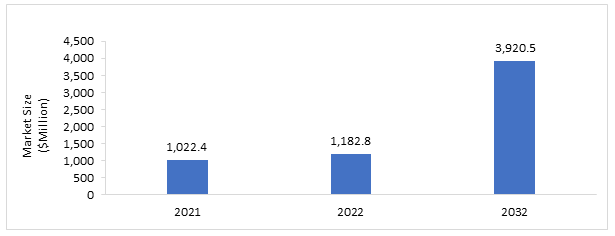Serum-Free Media Market Revenue Growth, Demand, Share, Size Estimation and Opportunity Forecast by 2032
Global serum-free media market has evolved to be an integrative aspect of healthcare procedures by providing most diagnostic laboratory tests equipped with infectious disease, oncology, and genetics. The massively parallel methods that have now transcended media-based cellular diagnostics further allow the sequencing of entire genomes at very low costs and are expected to grow further in the coming years due to the continuous increase in prognostic assessments for a wide range of diseases.
The global serum-free media market was valued at $1,022.4 million in 2021 and is expected to reach $3,920.5 million by 2032, registering a CAGR of 12.73% during the forecast period 2022-2032. The growth in the global serum-free media market is expected to be driven by factors such as the low risk of contamination in the media, rising awareness of media-based diagnostic testing, and significant number of funding for executing research and development.

Recent Developments in the Global Serum-Free Media Market
• In August 2022, Thermo Fisher Scientific Inc. expanded the cell culture media manufacturing facility in Grand Island, New York, to support the production of new vaccines and biologics. This expansion would support the worldwide media supply and increase the capacity to create high-quality technologies.
• In May 2022, FUJIFILM Irvine Scientific completed its new bioprocessing innovation and collaboration center in China. The new center would enable local resources and expertise required to optimize cell culture media and workflows to aid the production of vaccines, advanced therapies, and biotherapeutic drug development in China.
• In September 2021, Bio-Techne Corporation developed a new medium ExCellerate IpsC expansion medium, for IpsC research in regenerative medicine.
• In April 2021, PromoCell GmbH launched an upgrade to its Keratinocyte Cell Culture Portfolio. The company expanded its improved animal-extract-free Keratinocyte Growth Medium 3 for the standardized isolation and development of juvenile and adult Normal Human Keratinocytes.
• In March 2021, the company also launched its improved third-generation Melanocyte Cell Culture Portfolio. Melanocyte Growth Medium M3 is a serum-free, bovine pituitary extract (BPE)-free, and phorbol myristate acetate (PMA)-free media formulation.
Demand – Drivers and Limitations
Following are the demand drivers for the global serum-free media market:
• Low Risk of Contamination as a Demand Driver
• Launch of innovative products in Serum-Free Media Ecosystem
• Low reception cost involving small and medium enterprises in comparison to animal derived media
The market is expected to face some limitations too due to the following challenges:
• Slow Growth Rate in Comparison to Serum-Supplemented Media
• Requirement of Diverse Cell-Type for Specific Media Formulation
Key Market Players and Competition Synopsis
The companies that are profiled have been selected based on inputs gathered from primary experts and analyzing company coverage, product portfolio, and market penetration.

Some of the prominent names established in this market are:
Company Type 1: Serum-Free Media Private Industry
• MP BIOMEDICALS.
• HiMedia Laboratories
• RD Systems, Inc.
• Sino Biological, Inc.
• PAN-Biotech.
• PromoCell GmbH
• Athena Environmental Sciences, Inc.
• STEMCELL Technologies Inc.
Company Type 2: Serum-Free Media Public Industry
• Corning Incorporated
• Lonza Group AG
• Merck KgaA
• Sartorius AG
• Thermo Fisher Scientific Inc.
• FUJIFILM Holdings Corporation
• Danaher.
Key Questions Answered in Report
- What is the role of media type in serum-free media, and what are the advantages associated with serum-free media? What is the importance of recombinant proteins in cell culture applications?
- What are the key trends in the global serum-free media market? How is the market evolving, and what is its future scope?
- What are the major drivers, challenges, and opportunities of the global serum-free media market?
- What are the key developmental strategies implemented by the key players in the global serum-free media market to sustain the competition of the market? What is the percentage share of each of the key players in different key developmental strategies?
- What is the regulatory scenario of the global serum-free media market? What are the initiatives implemented by different governmental bodies and guidelines put forward to regulate the commercialization of serum-free media products?
BIS Related Studies
Comments
Post a Comment